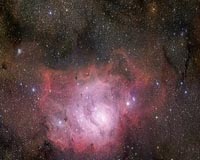 |
Sunspot NM (SPX) Oct 07, 2009 The history of the universe has yet to be revealed, but New Mexico State University astronomers are intent on unraveling its secrets, now that a new phase of a multiyear project has seen "first light." The Baryon Oscillation Spectroscopic Survey (BOSS), part of the Sloan Digital Sky Survey III (SDSS-III), took its first astronomical data on the night of Sept. 14. On that night, astronomers used the Sloan Foundation 2.5-meter telescope at Apache Point Observatory (APO) to measure the spectra of a thousand galaxies and quasars. The eventual goal is to collect spectra for 1.4 million galaxies and 160,000 quasars by 2014. "What BOSS is looking for are the ripples that are leftover from the formation of the universe," said Kurt Anderson, an NMSU astronomy professor and the APO site director. "We are trying to figure out the nature of the mysterious dark energy that leads to the expansion of the universe and creates cosmic acceleration." Apache Point, located in Sunspot in the Sacramento Mountains, operates four telescopes: the 3.5-meter Astrophysical Research Consortium (ARC) telescope, the 2.5-meter telescope of the Sloan Digital Sky Survey (SDSS), the 1.0-meter NMSU telescope, and the SDSS 0.5-meter photometric telescope. NMSU is a member of ARC and operates the observatory through the Department of Astronomy. SDSS is a collaboration between NMSU and several other institutions around the world to map the universe. The third phase of the survey builds upon recently completed projects to map the distribution of quasars and galaxies in space and the distribution of stars within our own galaxy. These projects have already produced the most detailed three-dimensional maps to date of our galaxy, the Milky Way, and the rest of the universe. "The data from BOSS will be the best ever obtained on the large-scale structure of the universe," said David Schlegel, of the U.S. Department of Energy's Lawrence Berkeley National Laboratory. Schlegel is the principal investigator of BOSS. BOSS uses the same telescope as the original Sloan Digital Sky Survey, but equipped with new, specially built spectrographs to measure the spectra. "The new spectrographs are much more efficient in infrared light," said Natalie Roe, of the Lawrence Berkeley Lab, who is the instrument scientist for BOSS. "The light emitted by distant galaxies arrives at Earth as infrared light, so these improved spectrographs are able to look much further back in time." Baryon oscillations began when pressure waves traveled through the early universe. Anderson said that as the universe expanded and cooled, the waves stopped, but left behind an acoustic signature, which appears as a ripple in the spatial distribution of galaxies. Through BOSS, he added, astronomers hope to learn how galaxies are formed, how dark matter is distributed, and insights into the nature of the enigmatic "dark energy," which is accelerating the expansion of the our universe. The BOSS spectrographs will work with more than two thousand large aluminum plates that are placed at the focal plane of the telescope; these plates are drilled with the precise locations of nearly two million objects across the northern sky. Optical fibers are plugged into a thousand tiny holes in each of these "plug plates" to carry the light from each observed galaxy or quasar to BOSS's new spectrographs. The four areas of the SDSS-III are BOSS, the second phase of Sloan Extension for Galactic Understanding and Exploration (SEGUE-2), the APO Galactic Evolution Experiment (APOGEE), and the Multi-object APO Radial Velocity Exoplanet Large-area Survey (MARVELS). BOSS, the largest of the four surveys in SDSS-III, includes more than 350 scientists from 42 institutions. The BOSS design and implementation has been led from the Lawrence Berkeley National Laboratory. The optical systems were designed and built at Johns Hopkins University, with new charge-coupled device (CCD) cameras designed and built at Princeton University and the University of California at Santa Cruz/Lick Observatory. The University of Washington contributed new optical fiber systems, and Ohio State University designed and built an upgraded BOSS data-acquisition system. The "fully depleted" 16-megaapixel CCDs for the red cameras evolved from Berkeley Lab research and were fabricated in that lab's Microsystems Laboratory. The SDSS-III is managed by the Astrophysical Research Consortium for the Participating Institutions of the SDSS-III Collaboration. These include the University of Arizona, the Brazilian Participation Group, the University of Cambridge, the University of Florida, the French Participation Group, the German Participation Group, the Michigan State/Notre Dame/Joint Institute for Nuclear Astrophysics Participation Group, Johns Hopkins University, the U.S. Department of Energy's Lawrence Berkeley National Laboratory, the Max Planck Institute for Astrophysics, NMSU, New York University, Ohio State University, Pennsylvania State University, the University of Portsmouth, Princeton University, the University of Tokyo, the University of Utah, Vanderbilt University, the University of Virginia and the University of Washington. Share This Article With Planet Earth
Related Links Sloan Digital Sky Survey III (SDSS-III) Astronomy News from Skynightly.com
 The Trilogy is Complete - GigaGalaxy Zoom Phase 3
The Trilogy is Complete - GigaGalaxy Zoom Phase 3Paris, France (SPX) Sep 29, 2009 The third image of ESO's GigaGalaxy Zoom project has just been released online, completing this eye-opening dive into our galactic home in outstanding fashion. The latest image follows on from views, released over the last two weeks, of the sky as seen with the unaided eye and through an amateur telescope. This third instalment provides another breathtaking vista of an astronomical object ... read more |
|
| The content herein, unless otherwise known to be public domain, are Copyright 1995-2009 - SpaceDaily. AFP and UPI Wire Stories are copyright Agence France-Presse and United Press International. ESA Portal Reports are copyright European Space Agency. All NASA sourced material is public domain. Additional copyrights may apply in whole or part to other bona fide parties. Advertising does not imply endorsement,agreement or approval of any opinions, statements or information provided by SpaceDaily on any Web page published or hosted by SpaceDaily. Privacy Statement |